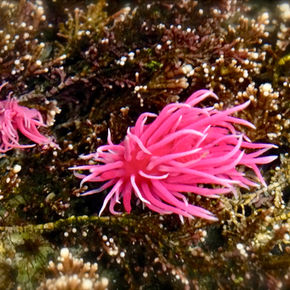
RESEARCH
THEMES
PROGRAMS & PROJECTS
Our research projects are continuously evolving as new researchers bring their own ideas into the SEACR Lab. You can read published articles here.
Coordinated regional management of introduced species through collective action in Suisun Marsh, CA
In Suisun Marsh (part of the San Francisco Bay and the Sacramento-San Joaquin Delta), invasive reeds can dramatically alter the marsh's physical characteristics and ecological interactions. In this project, we seek to understand how the invasive Phragmites australis (common reed) is changing predator-prey interactions and food web dynamics through the modulation of prey environments. We also seek to understand best practices, both ecological and social, to engage land holders in the management of their introduced species not just in their land, but across the entire marsh.
We collaborate with the Suisun Resource Conservation District, the US Geological Survey Invertebrate Zoology Laboratory, and David Ayers-Rypel Lab at UC Davis in this project funded by the California Sea Grant Delta Science Postdoctoral Fellowship and the Delta Stewardship Council. For more information, see here.
Multilingual participatory science programming for increasing climate literacy and advocacy
Environmental literacy is one of the most important indicators of advocacy behavior, but there are almost no resources in non-English languages to facilitated community learning. In this project, we prioritized the development of multilingual science curriculum for coastal intertidal habitats to increase the accessibility of these areas to Orange County residents with Spanish and Mandarin as their primary or only language. This curriculum uses our primary research on strategic communications for increasing climate literacy in the public, with the use of cultural values, metaphors, and a community solutions-oriented approach. The participatory science activity is based on our primary research in nudibranch ecology and physiology (see below).
This project is funded by the California Sea Grant Pathways to Inclusive Research Training Program and partners with six local advocacy groups to reach diverse communities: Citizens Climate Lobby, Climate Action Campaign, Sunrise Movement, Reform & Sustain, Orange County Environmental Justice, and the California Naturalists Program.
Evolution of beneficial plasticity in the eelgrass sea hare during unpredictable climate regimes
The eelgrass sea hare has many unique life history characteristics that make it an ideal system for studying the evolution of plasticity: it plays an ecologically important role as an epiphyte grazer, it has direct development, cannot disperse actively, has two generations per year in thermally disparate seasons, and withstands wide environmental variation within estuarine eelgrass beds. We found a wide range of populations expressing different reversible acclimation capacities and overall thermal tolerance. We were able to correlate this with underlying genetic profiles and look forward to using this knowledge to build physical models of sea hare passive dispersal to inform existing population structure and make recommendations for future restoration introductions. We also looked at developmental and transgenerational thermal tolerance plasticity, finding that future climate scenarios (both warming and extremes) decrease offspring success. We were also able to determine that persistence through thermally disparate seasons is due to plasticity in maternal provisioning, and future climate scenarios disrupt this "alternation of generations" in thermal tolerance due to a stress on energy budgets. In our current work, we seek to understand the genetic and epigenetic underpinnings of these physiological phenomena.
Strategic communication for community self-advocacy in California's urban environments
Understanding the cognitive science and linguistics of communication is essential to the appropriate distribution of scientific findings we produce as biologists. We have partnered with colleagues at the University of Florida and the University of California Agriculture and Natural Resources to expand tools for communicating about applied and climate sciences across audiences. We employ the framework developed by the National Network for Ocean and Climate Change Interpretation for effective, social science-based framing of scientific topics in both academic and informal education settings.
We use our framework of values, metaphors, and solutions to facilitate civic-minded discourse among the public, scientists, agencies, and historically marginalized stakeholder groups in local ecosystems. Most recently we have undertaken a new initiative to understand the framing of wetland restoration science in the California Bay-Delta.
Physiological, biochemical, and behavioral trade-offs in heat tolerance in nudibranchs
Temperate Eastern Pacific nudibranch species have high heat tolerance or high heat tolerance plasticity, but not both. We ask what behavioral, genetic, and/or physiological mechanisms drive this "trade-off" between thermal tolerance traits among species, and does this trade-off extend beyond temperate species?






